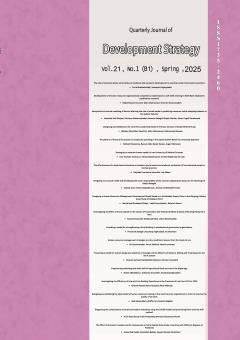Diagnosing the complications of small and medium industries using the CSCMP model and prioritizing them with the AHP method
Subject Areas : Economic
Amir hejrei
1
,
Nasser Fiqhi Farahmand
2
*
,
Mortaza Honarmand Azimi
3
![]()
1 - Doctoral student of Tabriz Department of Management, Islamic Azad University of Tabriz; Iran
2 - Associate Professor, Department of Management, Tabriz Branch, Islamic Azad University, Tabriz, Iran
3 - Department of Management, Tabriz Branch, Islamic Azad University, Tabriz, Iran
Keywords: small industries, medium industries, AHP prioritization,
Abstract :
The aim of this research is to identify the complications of small and medium shoe and leather industries in East Azerbaijan province using the CSCMP model and their prioritization with the AHP method. This research is descriptive based on survey in terms of practical purpose and in terms of research method, and analytical-mathematical in terms of research method. In this research, the statistical population related to the identification of complications in the shoe and leather industries is 92 experts and experts and managers of the mentioned industry. In this research, two types of questionnaires were made by the researcher to measure and measure the variables, one of which was for identifying the complications of the shoe and leather industries and the other questionnaire was for prioritizing the complications. To analyze the data of this research, descriptive statistics, factor analysis, text mining, CSCMP model and AHP method were used. Based on the results, 113 complications were identified based on the level of severity, including non-complication, mild, important, very important, and severe, so that 20% of the identified complications (22 cases) have "severe" weight and 27% also (30 cases) have been assigned a "very important" weight, which indicates the existence of 47% of the complications affecting the fate of the leather and shoe industries. Also, in a category, internal complications make up 72% and external complications make up 28% of them. Also, 92% of complications related to laws and regulations, 81% of complications related to political factors and industrial policies of the government, 70% of quality control and assurance were critical complications.
منابع:
- ابراهیمزاده پیلهورد، امیر (1399). تحلیل، عارضهیابی و بهبود فرایندها (مطالعه موردی: شرکت خودروسازی سایپا). پایان نامه کارشناسی ارشد، دانشکده مهندسی صنایع، دانشگاه صنعتی شریف.
- ایزدی، علی. (1399). طراحی یک مدل عارضهیابی زنجیره تامین و پیاده سازی آن در شرکت پارس بهین سیستم. پایان نامه کارشناسی ارشد. دانشکده مهندسی صنایع. دانشگاه صنعتی شریف.
- سایت اتاق صمت ایران، 1401.
- Beamon, B. M. (2019). Measuring supply chain performance. International Journal of Operations & Production Management , 19(3), 275-292.
- Chan F.T.S. Performance Measurement in a Supply Chain. International Journal of Advanced Manufacturing Technology , Vol. 21, (2011), 534–548.
- Chow, G., Heaver, T. D., & Henriksson, L. E. (2018). Logistics performance: definition and measurement. International Journal of Physical Distribution & Logistics Management , 24(1), 17-28.
- Liang L, Yang F, Cook W.D, Zhu J. DEA models for supply chain efficiency evaluation. Annals of Operations Research , Vol. 145, (2016), 3.
- Min, H., Thakkar, J., Kanda, A., & Deshmukh, S. (2011). Supply chain performance measurement framework for small and medium scale enterprises. Benchmarking: An International Journal , 16(5), 702-723.

